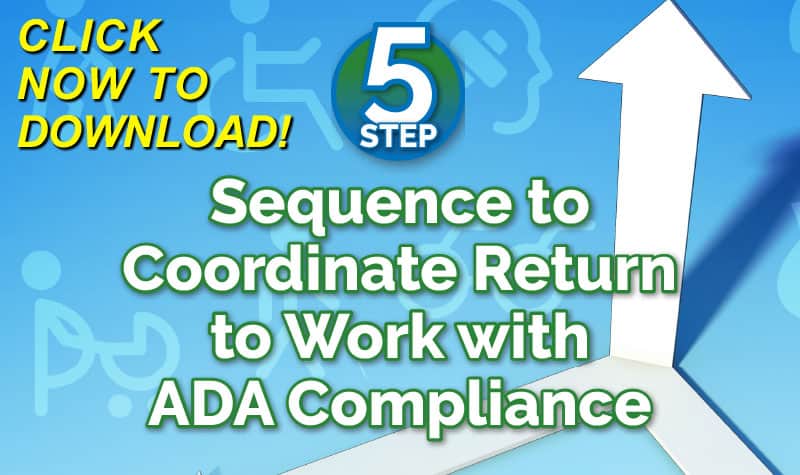
But competition among divisions can also be detrimental to an organization when rivalries are so strong they hold a company back from achieving its best results. Unfortunately, we see this all too often in the workers’ compensation system. Instead of sharing information, departments keep things close to the vest, leading to inefficiencies and unnecessary costs. Breaking down silos should be a goal of any organization aiming to achieve optimal outcomes for injured workers and avoiding wasted costs.
Click Link to Access Free PDF Download
“5-Step Sequence to Coordinate Return-to-Work with ADA Compliance”
Why Silos Exist
It’s no secret that collaboration leads to better results. But many organizations from all industries nevertheless struggle with the concept.
In a survey by McKinsey & Company several years ago
- 80 percent of senior executives said that “effective coordination across product, functional, and geographic lines was crucial for growth.”
- However, only 25 of the same respondents said their companies were effective at sharing knowledge across boundaries.
In workers’ compensation, this is especially counterproductive. HR, Risk Management, Accounting, and Safety departments all have information that, when taken as a whole, could expedite and streamline the claims process. But instead of working in concert, these divisions often won’t share information and may even work against each other.
The problem is the employees within each division have no incentive to work across silos. Rather than seeing one another as a means to a shared end, they view other divisions as competition. They believe if another division shines, their division will lose standing and be deemed less valuable.
Within these silos, employees develop negative views and attitudes toward workers in other divisions. They may come to view one another as unintelligent or unqualified and see other divisions and the employees within them as hurdles to getting their jobs done. Eventually, not only do divisions not speak with one another, but there is a breakdown in relationships among individuals.
There are a variety of things lacking when divisions work in isolation from one another:
- No overall vision.
- No common goal.
- Lack of an ideal of what the organization is trying to accomplish.
- No trust among divisions and their employees.
- Little or no respect for employees in other divisions.
- No understanding of what each division and each person is doing.
At this point, employers’ efforts to seek collaboration among various departments often fall flat.
What To Do
Clearly what is needed to remove the silos is to get everyone on the same page. While that may seem easier said than done, there are steps organizations can take to get employees throughout the company to work together. But it takes efforts on a couple of levels.
Organizational level
1. Companies need to have a vision and clear goals. C-suite executives need to identify what they want the company to accomplish.
2. Goals need to be clearly communicated to the entire organization.
- Managers and supervisors should be made to understand and embrace the organization’s vision and goals fully and share these with their employees.
- Company newsletters, brochures, emails and other sources of internal communication should continually drive home these points. They need to become part of the company culture.
- The CEO should convey the message of the vision and goals of the organization either through a letter to all employees or a video.
- It should explain the impact that workers’ injuries have on the organization; such as smaller raises or bonuses, fewer career growth opportunities, and less money for capital expenses.
- It should also include the idea that the organization truly cares about its employees, and underscore the negative effects an injury has on the affected worker, his family, and his colleagues.
3. Explain that by working together as an organization, everyone’s jobs can be made easier and there are opportunities for companywide improvement; when divisions work collaboratively, the entire organization benefits.
Individual Level
Personal relationships among employees in different divisions may need to be mended. This work, again, should start at the top. Relationships between division leaders may require some work.
Whether it involves division leaders or lower level employees, individual relationships can be mended. There are three steps in the process:
- Assume the best. When divisions have viewed one another as untrustworthy competitors, there may be assumptions that the other person doesn’t know what he is doing, does not bring much to the table, and has no idea of what is important. Instead, people should go into these meetings with the assumptions that the other person is intelligent and brings value to the organization. With that as a starting point, relationships can start to change.
- Ask other’s roles & responsibilities. Employees often have little or no idea what the other person does on a day to day basis. Start the conversation by asking what the other’s roles and responsibilities are, and their greatest challenges. This discussion can uncover all sorts of information, leading to ways each can help the other.
- Seek common ground. The participants should find out what each other likes, what their hobbies are, how they spend their leisure time. They may have kids around the same ages, or both like to go hiking, or they may have a common physical ailment. Whatever is common to both can be a topic to begin to bridge the relationship.
Conclusion
Organizations have an abundance of information at their disposal that could vastly improve their workers’ compensation systems. Unfortunately, many don’t take advantage of it due to the separations of divisions. By breaking down the silos, organizations can benefit from the synergism of working collaboratively and see improved success rates.

Author Michael Stack, CEO Amaxx LLC. He is an expert in workers’ compensation cost containment systems and helps employers reduce their workers’ comp costs by 20% to 50%. He works as a consultant to large and mid-market clients, is a co-author of Your Ultimate Guide To Mastering Workers Comp Costs, a comprehensive step-by-step manual of cost containment strategies based on hands-on field experience, and is founder & lead trainer of Amaxx Workers’ Comp Training Center.
Contact: mstack@reduceyourworkerscomp.com.
Workers’ Comp Roundup Blog: https://blog.reduceyourworkerscomp.com/
©2018 Amaxx LLC. All rights reserved under International Copyright Law.
Do not use this information without independent verification. All state laws vary. You should consult with your insurance broker, attorney, or qualified professional.








